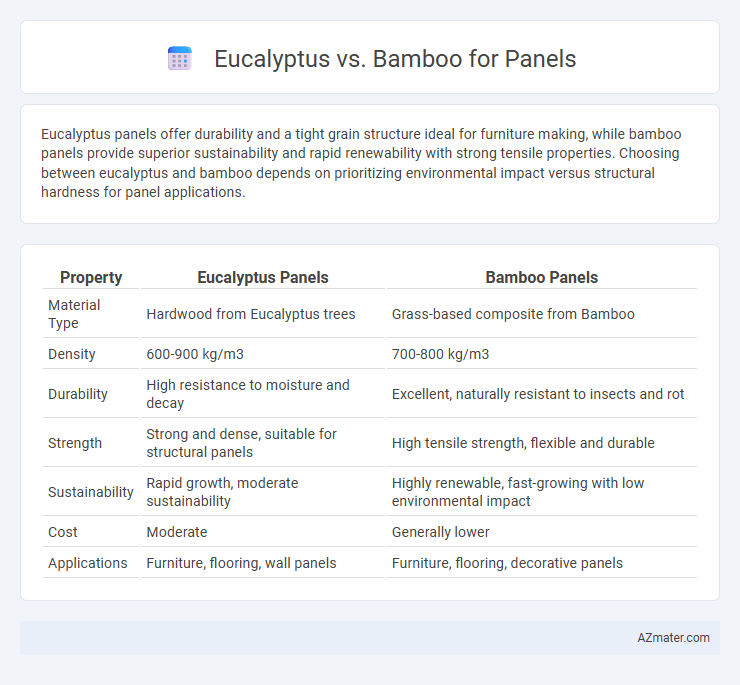Eucalyptus panels offer durability and a tight grain structure ideal for furniture making, while bamboo panels provide superior sustainability and rapid renewability with strong tensile properties. Choosing between eucalyptus and bamboo depends on prioritizing environmental impact versus structural hardness for panel applications.
Table of Comparison
| Property | Eucalyptus Panels | Bamboo Panels |
|---|---|---|
| Material Type | Hardwood from Eucalyptus trees | Grass-based composite from Bamboo |
| Density | 600-900 kg/m3 | 700-800 kg/m3 |
| Durability | High resistance to moisture and decay | Excellent, naturally resistant to insects and rot |
| Strength | Strong and dense, suitable for structural panels | High tensile strength, flexible and durable |
| Sustainability | Rapid growth, moderate sustainability | Highly renewable, fast-growing with low environmental impact |
| Cost | Moderate | Generally lower |
| Applications | Furniture, flooring, wall panels | Furniture, flooring, decorative panels |
Introduction to Eucalyptus and Bamboo Panels
Eucalyptus panels are crafted from fast-growing hardwood known for its durability, moisture resistance, and smooth finish, making it ideal for furniture and interior applications. Bamboo panels, derived from the segmented stalks of bamboo grass, offer exceptional strength, sustainability, and a unique grain pattern that enhances modern design aesthetics. Both materials provide eco-friendly alternatives to traditional wood panels, with eucalyptus emphasizing robustness and bamboo excelling in rapid renewability and lightweight properties.
Botanical Origins and Growth Rates
Eucalyptus, belonging to the Myrtaceae family, originates primarily from Australia and can achieve rapid growth rates of up to 3 meters per year under optimal conditions. Bamboo, classified under the Poaceae family, is a fast-growing grass native to Asia, capable of growing up to 91 cm per day, making it one of the fastest-growing plants on Earth. The contrasting botanical origins influence their structural properties and suitability for panel manufacturing, with eucalyptus providing dense hardwood and bamboo offering lightweight yet strong fibers.
Sustainability and Environmental Impact
Eucalyptus panels demonstrate rapid growth and high carbon sequestration rates, making them a sustainable choice for reducing deforestation and promoting reforestation. Bamboo offers exceptional renewability due to its fast propagation and ability to regenerate without replanting, significantly minimizing soil erosion and habitat disruption. Both materials contribute to lowering carbon footprints in panel production, with bamboo excelling in flexibility and eucalyptus providing durability and insect resistance.
Material Strength and Durability
Eucalyptus panels exhibit high material strength with a density ranging between 640-800 kg/m3, offering excellent resistance to impact and wear, making them suitable for structural applications. Bamboo panels, especially those made from strand-woven bamboo, boast a superior tensile strength of up to 370 MPa and natural flexibility, enhancing their durability in dynamic or fluctuating load environments. Both materials are naturally resistant to pests and moisture when properly treated, but eucalyptus generally requires more extensive preservation processes to achieve long-term durability comparable to bamboo's inherent resilience.
Appearance and Aesthetic Qualities
Eucalyptus panels exhibit a warm, rich grain with smooth texture and a consistent light to medium brown hue, creating a natural, inviting ambiance suitable for modern and rustic interiors. Bamboo panels offer a distinctive linear grain pattern with a lighter, creamy coloration and fine texture that enhances minimalist and contemporary designs through a clean and eco-friendly aesthetic. Both materials provide durability, but Eucalyptus emphasizes natural wood character while Bamboo highlights sustainability and sleek uniformity in appearance.
Panel Manufacturing Processes
Eucalyptus and bamboo differ significantly in panel manufacturing processes due to their structural properties and growth characteristics. Eucalyptus panels often require longer drying times and controlled kiln conditions to reduce moisture content and prevent warping, leveraging its dense hardwood fibers for robust furniture and construction applications. Bamboo panels utilize adhesive lamination and compression techniques to harness their rapid growth and tensile strength, enabling efficient production of lightweight, sustainable panels with high durability and flexibility.
Cost Comparison and Market Prices
Eucalyptus panels typically cost between $4 to $6 per square foot, offering a balance of durability and affordability, while bamboo panels range from $5 to $8 per square foot due to their rapid growth and sustainability appeal. Market prices for eucalyptus are influenced by regional availability and forestry practices, often making them cheaper in areas with abundant eucalyptus plantations. Bamboo's higher cost corresponds with eco-conscious consumer demand and the manufacturing process, positioning it as a premium choice in sustainable building materials.
Indoor Air Quality and Emissions
Eucalyptus panels release fewer volatile organic compounds (VOCs) compared to bamboo, contributing to better indoor air quality by minimizing harmful emissions. Bamboo panels can emit higher levels of formaldehyde, especially if bonded with urea-formaldehyde adhesives, potentially impacting respiratory health. Choosing sustainably sourced eucalyptus panels reduces indoor pollutants, making them a preferred option for healthier indoor environments.
Applications and Best Uses
Eucalyptus panels offer superior durability and resistance to moisture, making them ideal for outdoor furniture, flooring, and construction where strength and weather resistance are critical. Bamboo panels excel in lightweight applications such as interior wall cladding, decorative furniture, and eco-friendly packaging due to their fast growth rate and sustainable properties. Both materials provide versatile options, but eucalyptus prioritizes structural integrity while bamboo emphasizes sustainability and design flexibility.
Pros and Cons of Eucalyptus vs Bamboo Panels
Eucalyptus panels offer high durability and resistance to moisture, making them suitable for both indoor and outdoor use, but they can be heavier and more expensive compared to bamboo panels. Bamboo panels provide excellent sustainability, rapid renewability, and lightweight strength, ideal for eco-friendly construction, though they may be less moisture-resistant and prone to delamination over time. Both materials deliver distinct environmental benefits and performance characteristics, with eucalyptus excelling in robustness and bamboo favored for its rapid growth and flexibility.

Infographic: Eucalyptus vs Bamboo for Panel
 azmater.com
azmater.com